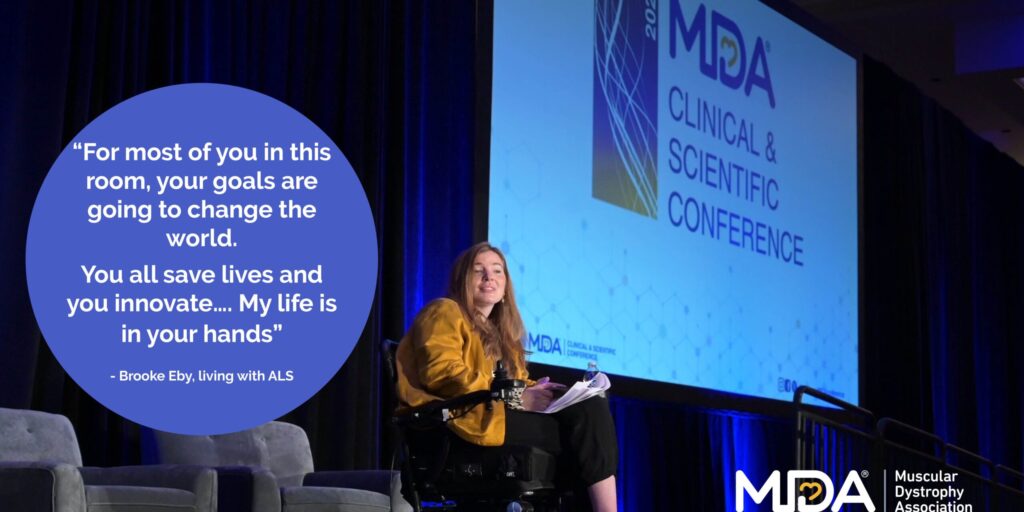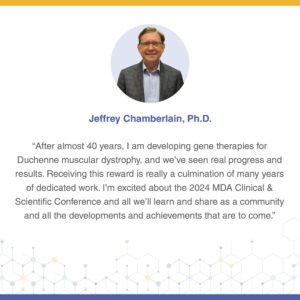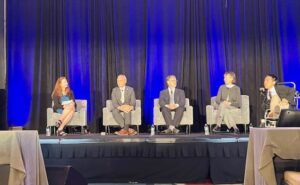
Heart of the Muscular Dystrophy Association Mission Was in Focus at the 2024 MDA Clinical & Scientific Conference Opening Day
By Amy Bernstein | Tuesday, March 5, 2024
Thousands of researchers, clinicians, affiliated healthcare providers, industry professionals, and patients from around the world gathered in Orlando, Florida, for the largest annual global gathering of the neuromuscular disease community at the 2024 MDA Clinical & Scientific Conference.

Donald S. Wood, PhD, President and CEO of the Muscular Dystrophy Association (MDA)
“When MDA was founded in 1950, we could not have held something called a clinical and scientific conference. Why? Because there were no scientists studying neuromuscular diseases in the entire United States,” said Donald S. Wood, PhD, President and CEO of the Muscular Dystrophy Association (MDA), in his opening address at the 2024 MDA Clinical & Scientific Conference on March 4.
Dr. Wood highlighted how the neuromuscular disease research and treatment landscape has changed dramatically since Louis Kunkel, PhD, identified the dystrophin gene in 1986. “We have gone from one clinician in the US to all these thousands of folks like you who are here today,” he said to the more than 2,000 people gathered in person and virtually from over 30 countries. This event brings together many of the world’s leading neuromuscular and genetic medicine professionals to present their research, form new collaborations, and learn the latest developments in the field.
The first day of the three-day conference highlighted the progress that has been made in research, care, and advocacy and featured vigorous discussions of what remains to be done, reminding attendees to be patient-centered in their work.
Recognizing accomplishments

Jeffery Chamberlain, PhD is the recipient of the MDA Legacy Award for Achievement in Research
Bringing home the point about progress, Alan Beggs, PhD, Director of the Manton Center for Orphan Disease Research at Boston Children’s Hospital, presented the MDA Legacy Award for Achievement in Research to Jeffery Chamberlain, PhD, a leading professor in gene therapy focused on Duchenne muscular dystrophy (DMD) at the Institute for Stem Cell and Regenerative Medicine at the University of Washington in Seattle.
Dr. Chamberlain received the first research grant MDA awarded for gene therapy 25 years ago and has made many important contributions to DMD research, including developing the miniaturized dystrophin gene used in several ongoing clinical trials for DMD. Recently, MDA funded a study for Dr. Chamberlain to develop a way to deliver a full-sized dystrophin gene.
MDA’s Legacy Award for Achievement in Research recognizes Dr. Chamberlain’s outstanding accomplishments in neuromuscular disease research and continued importance in the field.
Watch the award presentation here.
Patient-focused research

Brooke Eby, the keynote speaker for the 2024 MDA Clinical & Scientific Conference.
Brooke Eby, an ALS patient, advocate, and social media phenomenon who has been chronicling her journey with amyotrophic lateral sclerosis (ALS) since her diagnosis at the age of 33, delivered the conference keynote address, reminding the clinicians and researchers present of the urgency of their work.
“[ALS] forced me to live life in dog years; I have to make one equal seven,” she said. “I live at the speed of ALS. Therefore, you need to operate at the speed of ALS.”
With humor, she compared her credentials as a TikToker and employee at Salesforce to the MDs and PhDs who have delivered the conference keynote address in past years. “It’s true, I don’t have research experience or a medical background, but I am your ultimate stakeholder. I am the person living with the disease that you’re trying to end,” she said.
From that platform, she taught the audience how they can benefit from the goal-setting framework established by Salesforce, called V2MOM. This stands for vision, values, methods, obstacles, and measures.
“You will save lives and innovate. Your work is more important than anything in this world, especially in my world,” she told them. “With a goal as big as saving lives and finding cures, the more crucial it is to break it down into, one, what that goal really means, and two, how you’ll know if you’re being successful along the way.”
“If your stakeholders or patients or investment sources don’t know the goals and measurable plans to get to those goals, then you’re missing an opportunity — and we don’t have that kind of time,” she urged.
Watch Brooke’s full speech here.
Stimulating panel discussion
Brooke Eby’s keynote address was followed by a panel discussion moderated by Sharon Hesterlee, PhD, MDA’s Chief Research Officer. She was joined on the stage by Barry Byrne, MD, PhD, Director of the Powell Gene Therapy Center at the University of Florida; PJ Brooks, PhD, Acting Director of the Division of Rare Diseases Research Innovation at the National Center for Advancing Translational Sciences; Elizabeth McNally, MD, PhD, MDA Board Member and Director of the Center for Genetic Medicine at the Feinberg School of Medicine at Northwestern University; and Justin Moy, alumni MDA National Ambassador and a second-year PhD student in bioinformatics at Boston University who lives with LAMA2 congenital muscular dystrophy (CMD).

Panel led by Sharon Hesterlee, PhD, with Barry Byrne, MD, PhD, PJ Brooks, PhD, Elizabeth McNally, MD, PhD, and Justin Moy, alumni MDA National Ambassador
Dr. Hesterlee acknowledged that with 20 therapies for neuromuscular diseases approved in the last 10 years, “we are entering into what we’re calling the age of therapies.” Then, taking a cue from Brooke, she asked each panelist to share their own vision. Those visions largely rested on the potential of gene therapy and gene editing to treat neuromuscular diseases.
Dr. McNally compared her vision to the evolution of the cell phone. “Remember when we had big, giant brick phones? And then within about 12 years’ time we had an iPhone,” she said. “If that can be accomplished, we can solve the hurdles of gene therapy.”
They also addressed current obstacles to gene therapies, including the time it takes to develop them, the regulatory environment, getting patients diagnosed and making sure families know about the therapies, and the cost of gene therapies.
Among all the emphasis on gene therapies, Justin reminded researchers about the need to address symptoms that are important to patients beyond the root cause of a disease. There is still a need for therapies that address symptoms that impact daily life and mobility for people living with neuromuscular diseases, such as contractures.
Important gathering
Afternoon sessions provided conference participants with the latest information on topics ranging from newborn screening for neuromuscular diseases to streamlining care for pediatric neuromuscular diseases to how institutions can prepare to administer new gene therapies.
This conference presents an important opportunity for drug researchers working in laboratories, doctors and therapists caring for people with neuromuscular diseases, and community members living with these conditions to mingle and share their experiences and visions for the future.
Next Steps and Useful Resources
- Listen to a Quest Podcast interview with Brooke Eby.
- Find Science and Research updates and in-depth articles to help you understand this ever-evolving field.
- Stay up-to-date on Quest content! Subscribe to Quest Magazine and Newsletter.
TAGS: Featured Content, MDA Clinical and Scientific Conference, Research
TYPE: Blog Post
Disclaimer: No content on this site should ever be used as a substitute for direct medical advice from your doctor or other qualified clinician.




